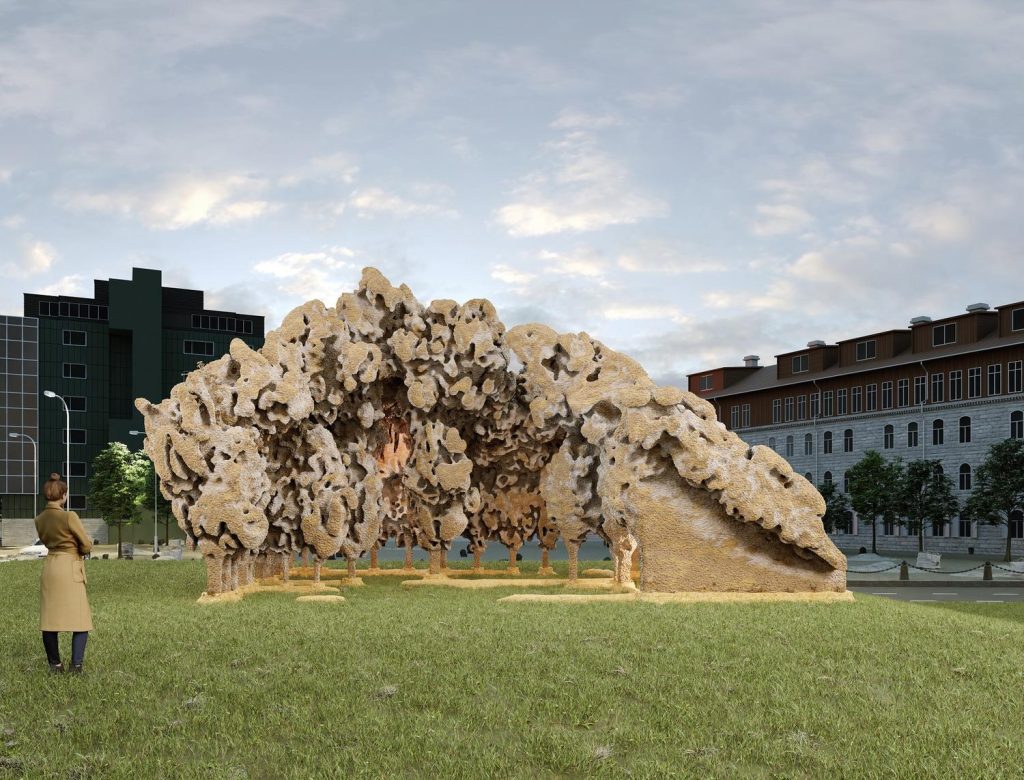Researchers at the University of Virginia (UVA) have developed a method of 3D printing living soils that could be used to construct future carbon-negative buildings.
Through the layer-by-layer extrusion of a novel seed-impregnated soil ‘ink,’ the UVA team’s approach enables the creation of self-supporting structures that facilitate the growth of plantlife. With further R&D, the researchers say their mixture could replace traditional, less sustainable construction materials, and enable the creation of wildlife-infused architecture that absorbs CO2 via photosynthesis.
“This method hypothesizes the creation of an active ecological system that might store emitted carbon in 3D printed soil structures,” said Ehsan Baharlou of the UVA’s School of Architecture. “The only electricity we need is to move the material and run a pump during printing. If we don’t need a printed piece or if it isn’t the right quality, we can recycle and reuse the material in the next batch of inks.”

Concrete’s high carbon footprint
To accurately measure the carbon footprint of a material, it’s necessary to calculate the total amount of CO2 emitted during its production. In the case of concrete, its manufacture relies on the burning of fossil fuels, while the cement part of its composition is made of an aggregate composed of sand and gravel, both of which are sourced from a limited natural supply, making it environmentally-taxing too.
As such, while CO2 emission studies have found that concrete is no more harmful to the environment than plastics or metals like steel, the sheer quantity of it used in construction makes its environmental impact so much greater.
In fact, in a Universidade de Lisboa sustainability study last year, researchers calculated that all the forests in the world aren’t enough to offset half the environmental impact of global aggregate and cement production. With this in mind, the UVA team has now come up with a novel soil-based alternative that can be 3D printed into large complex structures.
Initially, during the formulation of their material, the researchers used a desktop system to test two different approaches, one in which soil and seed were printed in sequential layers, and another where they were mixed beforehand. While both worked, it was found that as plants fight soil for water, the moisture content in their 3D printing ink would have a profound impact on the properties of resulting builds.
“3D printed soil tends to lose water more quickly and keeps a stronger grip on the water it has,” explained Ji Ma, the other UVA Assistant Professor on the project. “The reason we think this is the case is because the soil gets compacted. When the soil is squeezed through the nozzle, air bubbles are pushed out. When the soil loses air bubbles, it holds onto water more tightly.”

3D printing plant-infused buildings
Working with the nearby Blandy Experimental Farm scientific field station, the UVA team has gotten around potential issues surrounding soil moisture content, by incorporating seeds from very specific plants into their material. Specifically, the researchers have opted to use stonecrop, a plant capable of thriving with little water and growing directly on bare rock.
Since developing their revised ink, the team has begun 3D printing it into larger objects such as low walls around a meter in height, featuring plantlife that starts growing within a matter of days, and they’re now seeking to scale their approach.
Using funding awarded as part of the UVA’s 3Cavaliers grant scheme, Ma and Baharlou believe they’ve developed a 3D printing set up capable of doing so. By mounting an extruder to a robotic arm with a 3- to 4-foot reach, the pair have found it possible to begin depositing materials customized to yield structures with a desired space, function or geometry.
With the researchers predicting that building taller structures will exacerbate issues like soil cracking, they’re continuing to experiment with different plant and material blends, including botanicals such as hemp. However, the team say that ultimately the tech needed to 3D print robust structures exists, hence their ongoing work is focused on identifying a material that best takes advantage of its unique benefits.
“Regardless of the material – plastic, metal, clay, soil or plant life – in the end it’s a materials problem,” concluded Ma. “The additive manufacturing process creates uncertainties and opportunities within the material system you’re working with. You can approach this in different ways. You can try to avoid it and be afraid of it. Or you can try to control it and take advantage. That’s the long-term goal of our research.”

Understandably, given concrete’s role in the ongoing impact of global warming, a considerable amount of research is being conducted into finding greener 3D printable construction materials. Texas A&M university’s ‘hempcrete’ material, a feedstock made up of the hemp plant and a lime-based binder, recently gained backing via a $39 million ARPA-E grant targeted towards biomaterial R&D.
Australian architecture firm Simulaa, meanwhile, 3D printed a building from fungi for its entry to last year’s Tallinn Architecture Biennale. The exhibit was designed to grow and encompass its wooden base, before decaying in an algorithmic process leaving behind a tree-like ‘stump,’ in a process that signified the passage time.
The researchers’ findings are detailed in their paper titled “3D printing of ecologically active soil structures,” which was co-authored by S. Barnes, L. Kirssin, E. Needham, E. Baharlou, D. E. Carrc and J. Ma.
To stay up to date with the latest 3D printing news, don’t forget to subscribe to the 3D Printing Industry newsletter or follow us on Twitter or liking our page on Facebook.
While you’re here, why not subscribe to our Youtube channel? featuring discussion, debriefs, video shorts and webinar replays.
Are you looking for a job in the additive manufacturing industry? Visit 3D Printing Jobs for a selection of roles in the industry.
Featured image shows the UVA’s Ehsan Baharlou 3D printing a wall structure from living soil. Photo via the UVA.



